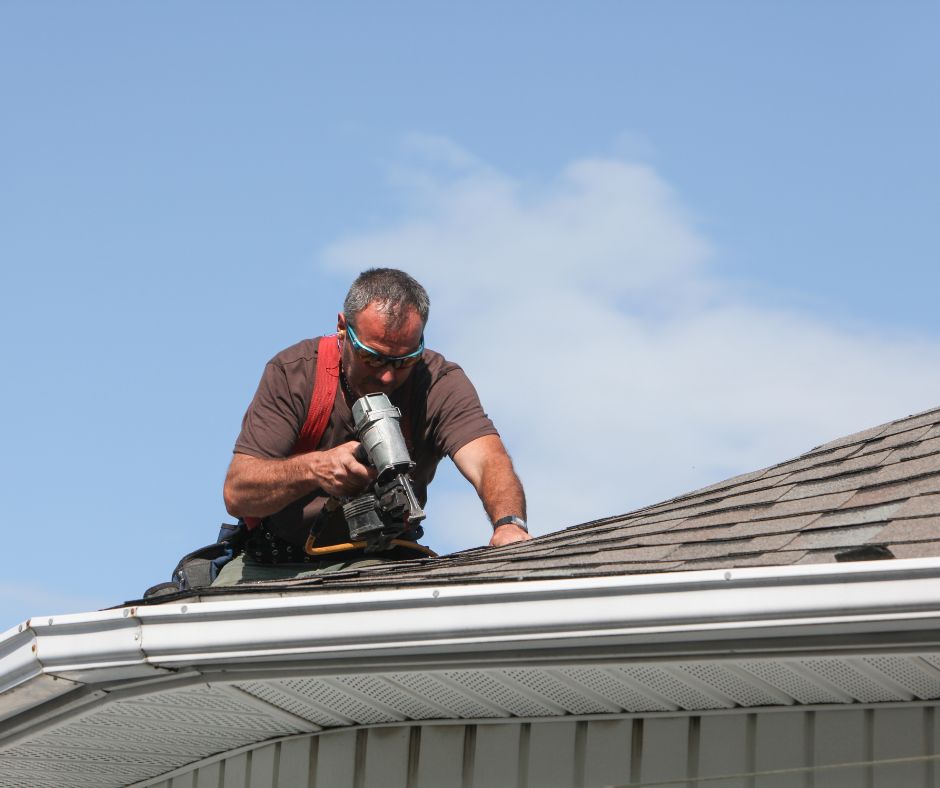The most common cause of roof leaks is missing or damaged shingles. These shingles are an essential barrier that shields the roof from elements like wind and rain. When shingles are not intact, water can easily seep underneath, causing leaks. Factors like strong winds, heavy rain, and regular wear and tear can contribute to this issue. Regular inspections by roofers in Winder will help identify and promptly replace any damaged shingles can prevent leaks. Understanding these primary causes can help you maintain a watertight roof.
Missing or Damaged Shingles
One of the most common causes of roof leaks is missing or damaged shingles, which can lead to water infiltration and subsequent issues within the roofing structure. Shingles are essential in protecting the roof from the elements, particularly water. When shingles are missing or damaged, they create openings through which water can seep into the foundational layers of the roof. This can result in water damage to the roof deck, insulation, and even the interior of the building.
Missing shingles can be caused by various factors, such as strong winds, heavy rain, or simply the natural wear and tear of the roofing material over time. Damaged shingles may occur due to improper installation, impact from falling debris, or exposure to extreme weather conditions. Regular inspections and maintenance can help identify and promptly address missing or damaged shingles, preventing potential leaks and extending the roof’s lifespan. Properly repairing or replacing these shingles is crucial in maintaining a watertight roofing system.
Poorly Installed Flashing
Poorly installed flashing is a common issue that can contribute significantly to roof leaks and water infiltration problems. Flashing is an essential roof system component designed to direct water away from vulnerable areas such as intersections, valleys, chimneys, skylights, and vents. When flashing is not installed correctly, gaps and spaces can form, allowing water to seep through and penetrate the roof structure.
Improperly installed flashing can result from various factors, including inexperienced installation, using low-quality materials, or simply neglecting to replace old or damaged flashing during roof repairs. Inadequate flashing can lead to significant water damage, mold growth, and structural issues within a building.
Clogged Gutters and Downspouts
Clogged gutters and downspouts are frequent problems that can lead to roof leaks and water damage if not promptly resolved. Gutters are crucial for directing water away from the roof and the foundation of a building. When gutters are blocked by leaves, debris, or other obstructions, water can pool on the roof, seep under shingles, and cause leaks. Additionally, if downspouts are clogged, water can back up and overflow, potentially damaging the roof’s structure.
Regular maintenance, including cleaning gutters and downspouts, is crucial to prevent clogs and ensure proper water drainage. This maintenance should be performed at least twice a year, usually in the spring and fall, or more frequently if trees surround the property. Installing gutter guards can also help prevent debris buildup and reduce the frequency of cleanings. By promptly addressing clogged gutters and downspouts, homeowners can avoid repairs caused by water damage and roof leaks.
Age and Wear of Roofing Materials
The longevity and condition of roofing materials are important in the potential for roof leaks and structural damage over time. As materials age, they become more susceptible to wear and tear, compromising their effectiveness in protecting the foundational structure. Shingles, for example, can become brittle and cracked due to prolonged exposure to the elements, making them less able to shed water effectively.
In addition to natural aging, improper installation or poor-quality materials can accelerate wear and tear, further increasing the risk of leaks. Regular inspections and maintenance can help identify signs of aging and wear early on, allowing for timely repairs or replacements to prevent more extensive damage. Addressing issues promptly can extend the lifespan of roofing materials and reduce the likelihood of leaks occurring due to age-related deterioration. Ultimately, proactive care and attention to the condition of roofing materials are essential in maintaining a watertight and structurally sound roof.
Other Roofing Tips

1 Comment
Can You Put a New Roof Over an Old One? | Premier Home Solutions
July 18, 2024[…] What Is the Most Common Cause Of Roof Leaks? […]